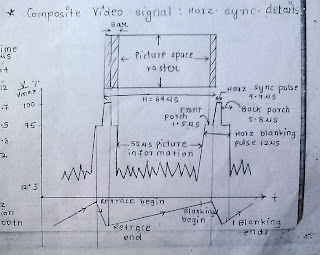Make sure you read the CVS in the order given below. Links to different CVS is given at end of this explanation.
There are 4 types of CVS viz.:
1. CVS for pedestal height
2. CVS for blanking pulses
3. CVS for horizontal sync detail
4. CVS for vertical sync detail
If in exam, a question comes as ‘Explain CVS’ then depending on the marks, explain anyone that you want to explain. For 5 marks, write any from first three. I’d prefer first one as it’s easy whereas if the question is for 10 marks, go for the 4th one. The one that I've explained below is the third one.
Click image to view full size
The total time required for horizontal trace and retrace is
64 µ seconds. Out of this 64 µ sec, 12 µ sec is line blanking period which
means it takes 12 µ sec for retrace. During this 12 µ sec, a synchronizing
pulse is added which is used to sync the horizontal scanning oscillator. This CVS explains how this 12 µ sec is actually divided.
The horizontal
line blanking period is divided into three parts:
- Front porch of 1.7 µ seconds.
- Line synchronizing pulse of 4.7 µ sec.
- Back porch of 5.8 µ sec.
1.7 µ sec + 4.7 µ sec + 5.8 µ sec = 12 µ sec
Front porch:
This is
known as front porch because it is added in front of the picture information. This
front porch allows the receiver circuitry to settle down from whatever level
exist at end of picture detail, to the blanking level before the synchronizing
pulse occurs (the sync pulses are always added at the blank level). Saw tooth waveform
is used for trace and retrace purpose. In the diagram below, the red line shows
the time taken for the receiver circuitry to go to the blank level.
Click image to view full size
Line sync
pulse:
After the
front porch ends, the retrace begins. These line sync pulses are inserted in
the CVS from transmitter’s side and are separated at the receiver. The main
function of these pulses is to keep the transmitter and distant receiver in
precise synchronization. The nominal time duration of this pulse is 4.7 µ sec.
Apart from providing synchronizing, the horizontal scanning oscillator uses
this pulse to complete its retrace. During this pulse, the beam completes its
fly back and comes to the extreme left of the raster (screen) so that it can
trace the next line.
Back porch:
This is known
as the back porch because it is added the back side of the next picture
information. It is nothing but an extension to the line sync pulse because this
period of 5.8 µ sec allows plenty of time for the fly back to complete. Apart
from this, it gives the horizontal scanning oscillator enough time to reverse
the direction of current. During retrace, the current flows from left to right
but for tracing the next line, the current should flow from right to left. For
this, reversing the direction of current flow is needed.
Click image to view full size
The timing
of back and front porch are so set that it creates black bars on right and left
side of the raster.
To get CVS - Pedestal height, Click Here
To get CVS - Blanking Pulse, Click Here
To get me on FB, Click Here




